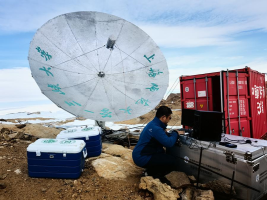Blog Credit: Trupti Thakur
Image Courtesy: Google
Switching
- When a user accesses the internet or another computer network outside their immediate location, messages are sent through the network of transmission media. This technique of transferring the information from one computer network to another network is known as switching.
- Switching in a computer network is achieved by using switches. A switch is a small hardware device which is used to join multiple computers together with one local area network (LAN).
- Network switches operate at layer 2 (Data link layer) in the OSI model.
- Switching is transparent to the user and does not require any configuration in the home network.
- Switches are used to forward the packets based on MAC addresses.
- A Switch is used to transfer the data only to the device that has been addressed. It verifies the destination address to route the packet appropriately.
- It is operated in full duplex mode.
- Packet collision is minimum as it directly communicates between source and destination.
- It does not broadcast the message as it works with limited bandwidth.
More Briefly Switching can be described as:
A process to forward packets coming in from one port to a port leading towards the destination. When data comes on a port it is called ingress, and when data leaves a port or goes out it is called egress. A communication system may include number of switches and nodes. At broad level, switching can be divided into two major categories:
- Connectionless:The data is forwarded on behalf of forwarding tables. No previous handshaking is required and acknowledgements are optional.
- Connection Oriented: Before switching data to be forwarded to destination, there is a need to pre-establish circuit along the path between both endpoints. Data is then forwarded on that circuit. After the transfer is completed, circuits can be kept for future use or can be turned down immediately.
Circuit Switching
When two nodes communicate with each other over a dedicated communication path, it is called circuit switching. There ‘is a need of pre-specified route from which data will travels and no other data is permitted. In circuit switching, to transfer the data, the circuit must be established so that the data transfer can occur.
Circuits can be permanent or temporary. Applications that use circuit switching may have to go through three phases:
- Establish a circuit
- Transfer the data
- Disconnect the circuit
Circuit switching was designed for voice applications. Telephone is the best suitable example of circuit switching. Before a user can make a call, a virtual path between caller and callee is established over the network.
Message Switching
This technique was somewhere in middle of circuit switching and packet switching. In message switching, the whole message is treated as a data unit and is switching / transferred in its entirety.
A switch working on message switching, first receives the whole message and buffers it until there are resources available to transfer it to the next hop. If the next hop is not having enough resource to accommodate large size message, the message is stored and switch waits.
This technique was considered substitute to circuit switching. As in circuit switching the whole path is blocked for two entities only. Message switching is replaced by packet switching. Message switching has the following drawbacks:
- Every switch in transit path needs enough storage to accommodate entire message.
- Because of store-and-forward technique and waits included until resources are available, message switching is very slow.
- Message switching was not a solution for streaming media and real-time applications.
Packet Switching
Shortcomings of message switching gave birth to an idea of packet switching. The entire message is broken down into smaller chunks called packets. The switching information is added in the header of each packet and transmitted independently.
It is easier for intermediate networking devices to store small size packets and they do not take much resources either on carrier path or in the internal memory of switches.
Packet switching enhances line efficiency as packets from multiple applications can be multiplexed over the carrier. The internet uses packet switching technique. Packet switching enables the user to differentiate data streams based on priorities. Packets are stored and forwarded according to their priority to provide quality of service.
Why is Switching Concept required?
Switching concept is developed because of the following reasons:
- Bandwidth: It is defined as the maximum transfer rate of a cable. It is a very critical and expensive resource. Therefore, switching techniques are used for the effective utilization of the bandwidth of a network.
- Collision: Collision is the effect that occurs when more than one device transmits the message over the same physical media, and they collide with each other. To overcome this problem, switching technology is implemented so that packets do not collide with each other.
Advantages of Switching:
- Switch increases the bandwidth of the network.
- It reduces the workload on individual PCs as it sends the information to only that device which has been addressed.
- It increases the overall performance of the network by reducing the traffic on the network.
- There will be less frame collision as switch creates the collision domain for each connection.
Disadvantages of Switching:
- A Switch is more expensive than network bridges.
- A Switch cannot determine the network connectivity issues easily.
- Proper designing and configuration of the switch are required to handle multicast packets.
Blog By: Trupti Thakur

10
JulSwitching
Jul 10, 2023Recent Blog
The Three Gorges Antarctic Eye TelescopeApr 09, 2025
When Monuments Delisted !!Apr 08, 2025
The Frontier Technologies Readiness IndexApr 07, 2025
Vikram 3201 & Kalpana 3201Apr 04, 2025
The Open Weight Language ModelApr 03, 2025




